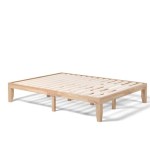The Size of a Queen and Full Bed: A Guide to Choosing the Right Fit
Choosing the right bed size is crucial for ensuring a comfortable and restful sleep. While many factors influence this decision, understanding the dimensions of different bed sizes is essential. This article delves into the specific measurements of queen and full beds, highlighting their differences, and providing insights to guide furniture selection.
Queen Bed Dimensions: A Spacious Option
Queen beds provide a spacious sleeping area suitable for individuals or couples who prioritize comfort and ample room to move around. They offer a balance between the smaller full size and the larger king size, making them a popular choice for many bedrooms.
Standard queen bed dimensions are 60 inches wide by 80 inches long. This provides ample space for two people to sleep comfortably. The extra width, compared to a full bed, allows for more freedom of movement and reduces the chance of waking up your partner if you sleep restlessly. This size is also ideal for larger individuals seeking additional room to stretch out comfortably.
Full Bed Dimensions: A Compact Choice
Full beds, also known as double beds, are a more compact option compared to queen beds. They offer a comfortable sleeping surface for one person and can accommodate two individuals if they are willing to compromise on space.
Standard full bed dimensions are 54 inches wide by 75 inches long. The narrower width means there is less space to spread out, making it more suitable for solo sleepers or couples who do not mind sleeping closer together. This can also be a practical choice for smaller bedrooms where maximizing floor space is important.
Key Differences Between Queen and Full Beds
The primary difference between queen and full beds lies in their width. A queen bed is six inches wider than a full bed, making it a significantly more spacious option. This extra width can be crucial for couples who need to toss and turn during sleep or for individuals who prefer to sleep with a lot of space to spread out.
Another important distinction is the length. Queen beds are five inches longer than full beds, offering additional legroom for taller individuals. This can be a significant advantage for taller sleepers who may find their feet protruding from the end of a full bed.
In terms of overall weight, queen beds are generally heavier than full beds due to their larger size and thicker mattresses. This difference may be a factor if you are moving or relocating your bed.
Choosing the Right Bed Size for Your Needs
The best bed size for you depends on several factors, including your individual needs, the size of your bedroom, and your budget.
If you are a solo sleeper with limited space, a full bed may be sufficient. However, if you share the bed or prefer ample room to move, a queen bed is a better choice. Consider the size of your bedroom, leaving enough space for furniture like nightstands and dressers. Additionally, remember that queen beds typically require a larger headboard and footboard than full beds.
Ultimately, the best way to determine the right bed size is to try out different options in person at a furniture store. Lie down on both a queen and a full bed to experience the difference in width and comfort. This will help you make an informed decision based on your personal preferences and space limitations.

Full Vs Queen Size Bed 2024 Mattress Nerd

Mattress Sizes Chart And Bed Dimensions Guide Amerisleep

Full Vs Queen Size Mattress What Is The Difference Nectar Sleep

Official Full Vs Queen Mattress Comparison Puffy

Full Vs Queen Bed Size Difference Comparison Sleep Advisor

Twin Vs Full Queen Which Mattress Size Is Right For You Dreamcloud

Full Bed Vs Queen Difference And Comparison Diffen

Full Vs Queen Bed Size What S The Difference

A Detailed Guide On Full Vs Queen Size Mattresses Which One Should You Sleep Turmerry

The Difference Between A Full And Queen Bed Bedinabox







